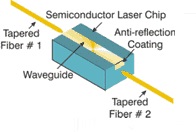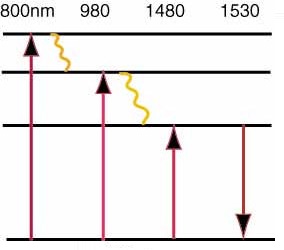Posted By: technopediasite
A passive optical network (PON) is a point-to-multipoint, fiber to the premises (FTTP) network architecture in which unpowered optical splitters are used to enable a single optical fiber to serve multiple premises.
Common Passive Components
Optical Connectors
Optical connectors, also called fiber optic connectors, is used for temporary or demountable joint connection of two pieces of optical fibers, cable or optical devices.
Couplers/Splitters
Coupler is an optical device that combines light from different fibers while splitter is an optical device that separates light into different fibers. In facet, in most cases, there is no difference between a coupler and a splitter, the function of the part is the same.
Optical Attenuator
Optical attenuators are devices that reduce transmitted light power in ia controlled manner. It is generally used in preserving a receiver from reaching saturation, wavelength power balancing, equalizing node power in multifiber-distribution network or testing.
Optical Isolaters
Optical isolators are devices that prevents the propagation of back‐reflected light. Optical isolators transmit light only in one direction.
Optical Circulator
Optical circulator is an unidirectional (non-reciprocal) divices directing an optical signal form one port to the next sequentially in only one direction at a time.
Optical Switches
Optical switch is a device used to dynamically control the physical
connections between input ports and output ports. There are many kinds
of optical switches according to their fabrication technology.
Many optical networks incorporate optical switches. Networks that require protection switching (switching between redundant paths), where key attributes must operate reliably after a long period in one position, system monitoring, and diagnosis commonly feature these devices
Opto-mechanical switches are the oldest type of optical switch and the most widely deployed at the time. These devices achieve switching by moving fiber or other bulk optic elements by means of stepper motors or relay arms. This causes them to be relatively slow with switching times in the 10-100 ms range.
Thermo-optic switches are normally based on waveguides made in polymers or silica. For operation, they rely on the change of refractive index with temperature created by a resistive heater placed above the waveguide. Their slowness does not limit them in current applications.
Electro-optic Switches are typically semiconductor-based, and their operation depends on the change of refractive index with electric field. This characteristic makes them intrinsically high-speed devices with low power consumption.
Optical Amplifier
With the demand for longer transmission lengths, optical amplifiers have become an essential component in long-haul fiber optic systems. Semiconductor optical amplifiers (SOAs), erbium doped fiber amplifiers (EDFAs), and Raman optical amplifiers lessen the effects of dispersion and attenuation allowing improved performance of long-haul optical systems.
Semiconductor optical amplifiers (SOAs) are essentially laser diodes, without end mirrors, which have fiber attached to both ends. They amplify any optical signal that comes from either fiber and transmit an amplified version of the signal out of the second fiber.
Optical Amplifier -- EDFA
The typical fiber amplifier works in the 1550 nm band and consists of a length of fiber doped with Erbium pumped with a laser at 980. The pump laser supplies the energy for the amplifier, while the incoming signal stimulates emission as the pulse passes through the doped fiber. The stimulated emission stimulates more emission, so there is a rapid, exponential growth of photons in the doped fiber. Gains of >40 dB (10,000X) are possible with power outputs >+20 dBm (100 mW).
Why Erbium?
Erbium's quantum levels also allow it to be excited by a signal at either 800nm or 980nm, both of which silica-based fiber can carry without great losses, but aren't in the middle of the signal wavelengths. Those bands are also far enough away from the signal bands that it is easy to keep the pump beam and the signal beam separated.
Optical Amplifier -- Raman Amplifier
Raman optical amplifiers differ in principle from EDFAs or conventional lasers in that they utilize stimulated Raman scattering (SRS) to create optical gain.
A Raman optical amplifier is little more that a high-power pump laser, and a WDM or directional coupler. The optical amplification occurs in the transmission fiber itself, distributed along the transmission path. Optical signals are amplified up to 10 dB in the
network optical fiber. The Raman optical amplifiers have a wide gain bandwidth (up to 10 nm). They can use any installed transmission optical fiber. Consequently, they reduce the effective span loss to improve noise performance by boosting the optical signal in transit.
External Optical Modulator
When data rates were in the low gigabit range and transmission distances were less than 100 km or so, most fiber optic transmitters used directly modulated lasers. However, as data rates and span lengths grew, waveguide chirp, caused by turning a laser on and off, limited data rates.
Elements of a Fiber Optic Link
A passive optical network (PON) is a point-to-multipoint, fiber to the premises (FTTP) network architecture in which unpowered optical splitters are used to enable a single optical fiber to serve multiple premises.
Common Passive Components
Optical Connectors
Optical connectors, also called fiber optic connectors, is used for temporary or demountable joint connection of two pieces of optical fibers, cable or optical devices.
Couplers/Splitters
Coupler is an optical device that combines light from different fibers while splitter is an optical device that separates light into different fibers. In facet, in most cases, there is no difference between a coupler and a splitter, the function of the part is the same.
 |
| Splitters |
Optical Attenuator
Optical attenuators are devices that reduce transmitted light power in ia controlled manner. It is generally used in preserving a receiver from reaching saturation, wavelength power balancing, equalizing node power in multifiber-distribution network or testing.
Optical Isolaters
Optical isolators are devices that prevents the propagation of back‐reflected light. Optical isolators transmit light only in one direction.
Optical Circulator
Optical circulator is an unidirectional (non-reciprocal) divices directing an optical signal form one port to the next sequentially in only one direction at a time.
Optical Switches
 |
| Switches |
Many optical networks incorporate optical switches. Networks that require protection switching (switching between redundant paths), where key attributes must operate reliably after a long period in one position, system monitoring, and diagnosis commonly feature these devices
Opto-mechanical switches are the oldest type of optical switch and the most widely deployed at the time. These devices achieve switching by moving fiber or other bulk optic elements by means of stepper motors or relay arms. This causes them to be relatively slow with switching times in the 10-100 ms range.
Thermo-optic switches are normally based on waveguides made in polymers or silica. For operation, they rely on the change of refractive index with temperature created by a resistive heater placed above the waveguide. Their slowness does not limit them in current applications.
Electro-optic Switches are typically semiconductor-based, and their operation depends on the change of refractive index with electric field. This characteristic makes them intrinsically high-speed devices with low power consumption.
Optical Amplifier
 |
| Apmlifier |
Semiconductor optical amplifiers (SOAs) are essentially laser diodes, without end mirrors, which have fiber attached to both ends. They amplify any optical signal that comes from either fiber and transmit an amplified version of the signal out of the second fiber.
Optical Amplifier -- EDFA
 |
| Optical Amplifier- EDFA |
Why Erbium?
Erbium's quantum levels also allow it to be excited by a signal at either 800nm or 980nm, both of which silica-based fiber can carry without great losses, but aren't in the middle of the signal wavelengths. Those bands are also far enough away from the signal bands that it is easy to keep the pump beam and the signal beam separated.
 |
| Erbium |
Optical Amplifier -- Raman Amplifier
Raman optical amplifiers differ in principle from EDFAs or conventional lasers in that they utilize stimulated Raman scattering (SRS) to create optical gain.
 |
| Raman Optical Amplifier |
A Raman optical amplifier is little more that a high-power pump laser, and a WDM or directional coupler. The optical amplification occurs in the transmission fiber itself, distributed along the transmission path. Optical signals are amplified up to 10 dB in the
network optical fiber. The Raman optical amplifiers have a wide gain bandwidth (up to 10 nm). They can use any installed transmission optical fiber. Consequently, they reduce the effective span loss to improve noise performance by boosting the optical signal in transit.
External Optical Modulator
When data rates were in the low gigabit range and transmission distances were less than 100 km or so, most fiber optic transmitters used directly modulated lasers. However, as data rates and span lengths grew, waveguide chirp, caused by turning a laser on and off, limited data rates.
Elements of a Fiber Optic Link
 |
| Elements of Optic Link |





2 Comments
Nice article, Which you have shared here about the Optical Fiber Passive and Active Components. Your article is very informative and useful to know more about the fiber optic technology. Thank you for sharing this article here.
ReplyDeleteGelcoats provide both excellent protection for structural laminates as well as the levels of gloss and colour retention. Thermal sprayed aluminium coatings provide wear and corrosion resistant coatings. Composite Mould Release
ReplyDelete